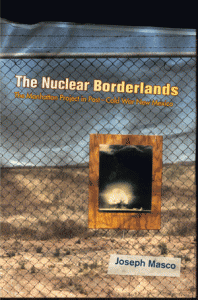This summer marked the passing of a birthday of sorts, the 25th anniversary of the first identification of AIDS in the United States. Although there is conclusive and still-emerging evidence that people died of AIDS at least as early as the mid-twentieth-century in Africa, it was the appearance of a rare form of pneumonia in otherwise healthy young men in Los Angeles that began to concern the U.S. Centers for Disease Control in 1981. National attention focused on “AIDS at 25,” as for example on the cover of Newsweek.
In San Francisco’s legendary Castro neighborhood, year 25 of the epidemic was recognized by community organizers with a banner mounted on the side of a Bank of America building at the corner of 18th and Castro. (The same site became a make-shift memorial to Princess Diana when she died; it was also the site of a little noticed memorial to both Jacques Derrida and Rodney Dangerfield the week that they died.) Organizers created large papier mache flowers that drooped over the Castro for a week or so. But though the gay community was ‘officially’ remembering this tragic event in its history, no one I know in my clique of thirtysomething denizens of the gay ghetto actually talked about it. The flowers just hung there and then went away.
HIV/AIDS is in the public eye again, in part because of the 2006 international AIDS conference in Toronto, which just ended. Reports from the conference indicate that the big ‘Double Bill’ session, featuring two of the world’s most famous and powerful men — Bill Gates and Bill Clinton — was standing room only. News is hopeful: antiretroviral drugs have dramatically transformed the disease from a terminal syndrome to something like a manageable chronic illness. These drugs reduce fatality, they can reduce infection, and they are very expensive. Massive funding will be needed to get these medications to the people in poor places who badly need them, and these include parts of the United States. Controversy swirls around whether or not U.S. initiatives aimed at Africa are constrained by the moralistic and inefficacious imperatives of the Bush regime. The consensus appears to be that because the means to hasten an end to the epidemic are now available, there is now a collective moral burden to make these means available to those whose lives they could save.
Meanwhile, in the United States, recent developments in HIV, law, and public health may be of interest to social anthropologists, especially those who work at the interstices of government, public health, medical technologies, and kinship. Reasons are manifold (AIDS disproportionately affects marginalized people, policy sometimes depends on knowledge of sexual practices and social networks that ethnographic methods uniquely reveal, the epidemic of its very nature mobilizes complex inter-connected/sometimes fractious social relations of vastly different orders [between sex partners, between ‘North’ and ‘South’]). I am am presently trying to think through some aspects of HIV/AIDS from a social perspective. I am interested in how different kinds of persons and publics are summoned by HIV. An example:
This image is from a pervasive social marketing campaign in the United States. You can see it, and similar ads, on the sides of buses or trams, in subway stations, on billboards, all over major urban areas. This year, I noticed several of these advertisements in San Francisco that were timed to coincide with National HIV Testing day. Here is an abundantly happy couple: attractive, apparently quite in love. The ‘know’ — knowledge of HIV status — the campaign assures us, is ‘spreading,’ to my mind an unfortunate metaphor in the context of an epidemic. Who is hailed in this call to gain self-knowledge? What indeed does this couple know? What is implied about the relationship between them? What does the advertisement ask its viewers to do? What does it promise them?
In upcoming posts, I will hazard an analysis of some current U.S. HIV prevention strategies, paying attention especially to ways that they construct ‘the public’ and its good. Recent emphasis on individual HIV testing, combined with legal decisions that criminalize the transmission of HIV between persons (and that problematize the status of one’s self-knowledge in the context of HIV), raise vital questions about individual agency and community responsibility. A provocation: suppose the person who responds to the “Know HIV/AIDS // No HIV/AIDS campaign” tests positive for HIV. How will this advertisement and ones like it frame the experience, its meanings, its psychological effects, its social entailments?
In an era in which biomedical interpellation is a pervasive and over-riding fact of life, the means and meanings of medical testing bear ethnographic inspection and social reflection.

 Would it be unfair to say that this image basically sums up the content of mainstream U.S. politics and culture since “9/11”? Where does this picture fit amidst arguments about the clash of civilizations, the politics of oil, the legality of torture, secularism, multiculturalism, or the exercise of sovereign power? Does the image of George W. Bush as a roided-out Uncle Sam basically iconize the post-millenial U.S. zeitgeist?
Would it be unfair to say that this image basically sums up the content of mainstream U.S. politics and culture since “9/11”? Where does this picture fit amidst arguments about the clash of civilizations, the politics of oil, the legality of torture, secularism, multiculturalism, or the exercise of sovereign power? Does the image of George W. Bush as a roided-out Uncle Sam basically iconize the post-millenial U.S. zeitgeist?
